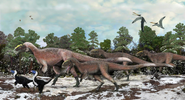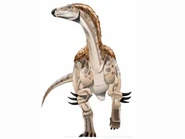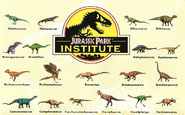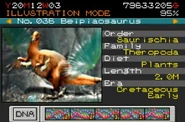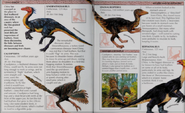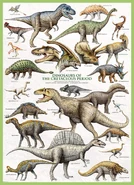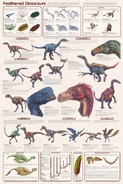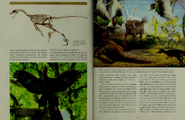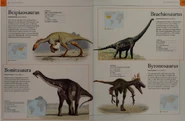| Beipiaosaurus | |
|---|---|
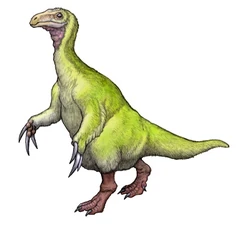
| |
| Scientific classification | |
| Kingdom: | Animalia |
| Phylum: | Chordata |
| clade: | Dinosauria |
| Order: | Saurischia |
| Suborder: | Theropoda |
| Superfamily: | †Therizinosauroidea |
| Genus: | †Batodonoides Xu, Tang & Wang, 1999 |
| Species: | †B. inexpectus |
| Binomial name | |
| †Beipiaosaurus inexpectus Xu, Tang & Wang, 1999 | |
Beipiaosaurus bei·pi·ao·saur·us(pronounced bye-PEE-oh-SORE-us) was a species of small, primitive therizinosaur closely related to Nothronychus and Therizinosaurus. It lived during the Early Cretaceous Period 125 million years ago in what is now China, and at one point was the largest known dinosaur with confirmed evidence of feathers (mainly for its time period).
Discovery
In 1996, a humble peasant named Li Yinxian found the fossilzed bones of a dinosaur near the town of Sihetun in China. However, it wasn't until 1999 that the fossils were rediscoverd, examined, and named by paleontologists Xu

Beipiaosaurus Skelton with Feather Indents
Xing, Tang Zhilu, and Wang Xiaolin, and later published in an article in the Nature Magazine. The specimen was named Beipiaosaurus inexpectus, or "unexpected Baipiao lizard". At first, base on the peg-like teeth, scientists thought it was a species of prosauropod, like Plateosaurus, but when more specimens of dinosaurs with long necks, big bodies, extending arms with clawed hands, and theropod-like feet were discovered, they realized Beipiaosaurus was part of a genus of dinosaurs now called therizinosaurs. What makes Beipiaosaurus special, though, is scintists now know that, based off its primitive appearance, therizinosaurs actually evolved from coelurosaurs like dromaeosaurids (Raptors) rather than sauropodomorphs or ornithiscians as thought of previously. It also, from very well-preserved specimens, clued us in that therizinosaurs more than likely had feathers overing their whole bodies.
Appearance
Like other therizinosaurs, Beipiaosaurus had a long neck and small head for reaching into trees easier, giving itself an almost sauropod look. It also had very long arms and wicked claws on each of its fingers for stripping trees of their bark and leaves, and also likely were used for defense against predators. Its body was rather stout, likely ending in a sort of pot-belly, but was much leaner than that of other larger, more evolved therizinosaurs. Beipiaosaurus jaws started out with a beak in the front and then had peg-like cheek teeth more towards the back, for stripping vegetation more efficiently. However, the teeth weren't very good for sauropod look. It also had very long arms and wicked claws on each of its fingers for stripping trees of their bark and leaves, and also likely were used for defense against predators. Its body was rather stout, likely ending in a sort of pot-belly, but was much leaner than that of other larger, more evolved therizinosaurs.
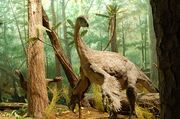
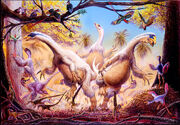
It grew to be about 7.5 feet (2.6 meters) long, 4 feet (1.3 meters) long, and 100 pounds (45 kilograms) in weight, making it quite small in terms of therizinosaur and dinosaur standards. Nevertheless, its discovery was an important find in the fossil record for piecing together therizinosaur evolution. As far as we know, Beipiaosaurus had the longest feathers of any known dinosaur, and during the mating season were likely used to attract mates like modern birds do. Being a more primitive therizinosaur also sets it apart from other species related to it, such as features like a slender body and shorter neck. Its legs were also relatively longer than in relatives such as Therizinosaurus, suggesting it was a faster runner. Baiepiaosaurus is also unique in its feet; while other, more evolved therizinosaurs had three toes, it had four that were all functional, and gives another hint that it likely evolved from maniraptoran dinosaurs. Some people think that it may have had an appearance similar to a Panda.
In the Media
Beipiaosaurus made an appearance in the 13th movie of the Land Before Time series, although one couldn't really tell without some reference. Unfortunately, these Beipiaosaurus (called Yellow Bellies in the film in reference to the color of their big bellies) don't particularly resemble their real life counterparts all that well.
- Their claws are too short and are depicted with four fingers, as opposed to the three fingers possessed by the real animal. Beipiaosaurus was a therizinosaur, so it would have had longer claws than what is shown in the film.
- While correctly depicted with feathers, they lack a full feathered coat and only have sprouting feathers.
- They lack the tail of the real animal aside from the ponytail stream of feathers.
They will make an appearance in the "Recode" of the video game The Isle, where it will have niche and body plan more like that of a duck or other waterfowl than its real life version.
Gallery
References
http://en.wikipedia.org/wiki/Beipiaosaurus
http://www.prehistoric-wildlife.com/species/b/beipiaosaurus.html
http://ageofdinosaurs.com/dinosaurs/beipiaosaurus.htm
http://blog.everythingdinosaur.co.uk/blog/_archives/2010/01/28/4439891.html
